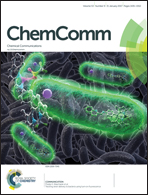A cell-permeable and triazole-forming fluorescent probe for glycoconjugate imaging in live cells†
Abstract
A new fluorescence-forming probe, coumOCT, designed by fusing cyclooctyne with a coumarin fluorophore was successfully used for the imaging of azido-glycoconjugates in living HeLa cells. This probe is cell-permeable and generates fluorescence after triazole formation, thus minimizing the background signal and enabling the real-time intracellular imaging of glycoconjugate trafficking.



 Please wait while we load your content...
Please wait while we load your content...